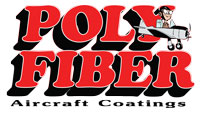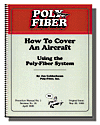 |
What's So Good
About the Poly-Fiber
Fabric Covering System?
|
 It's A Complete System -- No More Shopping Around! It's A Complete System -- No More Shopping Around!- When you cover your airplane with Poly-Fiber, you get everything you need. All the tools and materials.
 -
 The Best Manual in the Business! The Best Manual in the Business!- 135 pages of step-by-step instruction, helpful photos, great nostalgic cartoons, extra words of wisdom, and a delightful sense of humor. And we've included the entire catalog of products, everything from fabrics to stirring paddles.
-
 You'll Like Our Aggressive Factory Support! You'll Like Our Aggressive Factory Support!- We have an 800 number for Technical Support, not just sales. Or address your e-mail to
fabric@preferredairparts.com. -
  There's An Instructional Video. There's An Instructional Video.- This 1-3/4 hour video is produced by Alexander Promotions in cooperation with EAA SportAir Workshops. This comprehensive video presents every aspect of the Poly-Fiber fabric covering process in detail, with easy-to-understand instruction. You'll see: Preparing the surfaces for covering, attaching the fabric to the airframe, tightening the fabric with an ordinary iron, applying the first coat of Poly-Brush, tying the special rib-lacing knots, applying the finishing tapes, spraying the UV-blockeer Poly-Spray, and applying the final color coats.
-
 You Always Have Worldwide Availability. You Always Have Worldwide Availability.- We cover the US and Canada, and much of the world. You can always get the Poly-Fiber product you need.
-
 "Why should I use Poly-Fiber?" "Why should I use Poly-Fiber?"
- Poly-Fiber is the only all-VINYL system on the market today. As it dries, it bonds extremely well to today's polyester fabrics and remains flexible.
- Poly-Fiber does not support combustion.
- Poly-Fiber is one of the lightest systems available. Only eight coats are used. There are lightweight options, too.
- Poly-Fiber is the most repairable of all systems available today, and the repairs are as strong as the original.
- Poly-Fiber can be rejuvenated after years of weathering.
- It has over 30 years of success as the Stits Poly-Fiber system. Many original jobs done 30 years ago are still going strong.
- Poly-Fiber is not particularly sensitive to heat, cold, or humidity during application or throughout its service life.
- Poly-Fiber offers choices in fabric weights and types of top coat paints. There are over 100 different top coat colors.
- Poly-Fiber has options for every aircraft from a simple ultralight to the most sophisticated warbird.
 "Is Poly-Fiber more expensive than other systems?" "Is Poly-Fiber more expensive than other systems?"
No, they all cost about the same! Although dope costs less per can than Poly-Fiber, you use twice as much dope as Poly-Fiber. Price them out for yourself. You'll find they pretty much even out.
  "How many steps are there?" "How many steps are there?"- There are just six basic steps:
- 1. Glue on the fabric with our Poly-Tak fabric cement; tighten it with the heat of a calibrated clothing iron.
- 2. Brush on a coat of Poly-Brush fabric sealer.
- 3. Riblace, then apply gussets and finishing tapes with more Poly-Brush.
- 4. Spray on two more coats of Poly-Brush.
- 5. Spray on three cross coats of silver Poly-Spray to block ultraviolet radiation.
- 6. Spray on two coats of top coat paint, either Poly-Tone or Aero-Thane.
-
 "That's eight coats. How much does that weigh?" "That's eight coats. How much does that weigh?"- Surprising little. A Cub will only gain about 40-45 pounds, not the usual 75. Smaller aircraft and ultralights average about 20 to 25 pounds. For extreme ultralights it's possible to skip some steps and get down to 12 to 15 pounds, but this covering won't have all the capabilities of the full eight-coat system.
-
 "Can I use automotive paint over a Poly-Fiber base?" "Can I use automotive paint over a Poly-Fiber base?"- We really strongly discourage that idea. Over the years, automotive paints, even the ones with flex agents, crack when used over fabric. We sell two paint systems: Poly-Tone, a repairable semi-gloss paint that can be buffed to a nice satin sheen; and Aero-Thane, a high-gloss "wet-look" polyurethane. Both are specially formulated to flex with the fabric and resist cracking for years. Your automotive paint may look great when you first put it on, but you'll hate yourself a few years later when it starts falling off. Click here to view the choice of 50 brilliant colors... all available in both types of Poly-Fiber Paint.
-
 "What do I need from start to finish?" "What do I need from start to finish?"- We'll use a Cub as our example. Naturally, your list depends upon what you're covering, and you can scale things up or down as needed. You will need: 45 Yards of Poly-Fiber Med-1 fabric, 6 rolls of 2 inch Med-1 finishing tape, 1 roll of 4 inch Med-1 finishing tape, 1 roll of rib lacing cord, 2 rolls of 1/2 inch reinforcing tape, 2 rolls of inter-rib brace tape, 1 roll of cloth anti-chafe tape, 100 plastic drain grommets, 30 inspection rings, 25 inspection ring covers, 1 gallon Poly-Tak, 8 gallons Poly-Brush, 11 gallons Poly-Spray, 5 gallons Reducer, and 11 gallons Poly-Tone color.
THE TOOLS YOU'LL NEED
- Fuselage holding and turning jig.
- Sturdy sawhorses, about 3' high; pad the tops with carpet scraps; great for wings and tail surfaces.
- A nice big sturdy snag-free table will make handling and cutting fabric much easier.
- Drop cloths to protect floor, cover airframe parts, etc.
- An electric iron -- don't use your wife's!
- A small "sealing" iron -- great for tapes, patches, and hard-to-reach areas.
- Thermometers to calibrate irons.
- Heat sink compound.
- An effective respirator, plus extra filters.
- Brushes: 1", 2", 3", and 4".
- Glue brushes, 1/2" wide (acid brushes are good).
- Sandpaper: 400 grit.
- Two 12" straight and two 12" curved rib lacing needles.
- Sharp scissors; polyester fabric dulls them quickly, so buy a few pairs of cheap ones.
- Pinking shears -- buy a good pair and wear them on a cord around your neck; if you drop them, they're ruined.
- Sharp X-Acto or other knife.
- Paint spray gun and accessories (see below).
- Cotton rags -- do NOT use shop rags; they aren't clean enough and residual silicon will ruin your work.
- Paper towels.
- Scotch Brite pads, ultra fine.
- Single-edge razor blades -- buy a big box.
- Chalk snap line.
- Measuring tape.
- Paint stirring paddles.
- Paint filter cones, 60x48 or finer mesh.
- Soup ladle.
- Lots of clean soup and coffee cans with tight lids.
- Small wide-neck container to use as a glue pot.
- Craft masking paper (don't use newspaper).
- Six spring clamps with 2" throats -- for holding fabric.
- Wooden spring clothes pins -- great for fabric work.
- T-head pins.
- Tack cloths -- for cleaning just before painting.
Our primary goal is to provide you with the products you need to cover your airplane PLUS the clear concise instruction you need to use those products to complete the job.
©2020 Preferred Airparts, LLC All rights reserved.
|

















